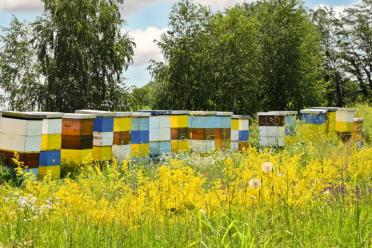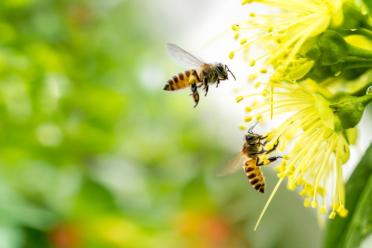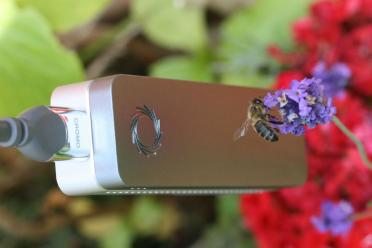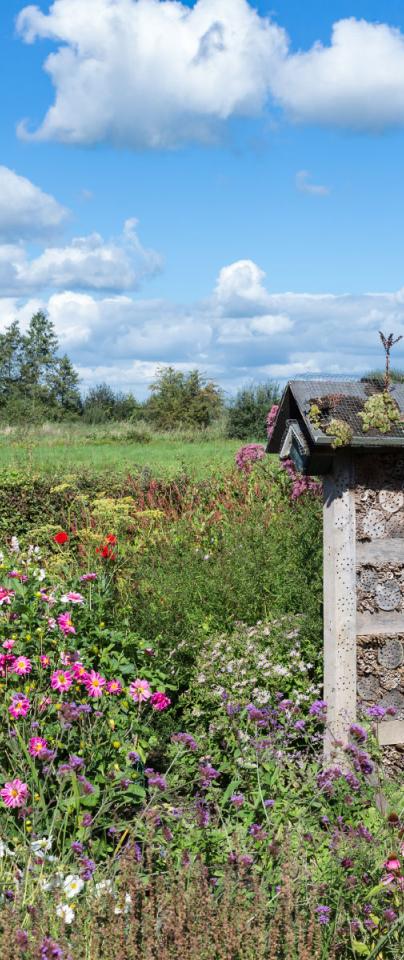Three ways EI is helping bees
Throughout this Summer, we are celebrating our precious pollinators and the work our scientists are doing to aid their long-term survival.
Bees are essential for life as we know it. Thanks to their pollination of crops and wildflowers, we can enjoy the food and environment we so often take for granted. Without them, supermarket shelves would be scarce of fruits and vegetables. Througout the Summer, we are celebrating our precious pollinators and the work our scientists are doing to aid their long-term survival.
The headlines around bee decline make depressing reading, with some touting the dawning of a sixth mass extinction. Habitat loss, insecticides and environmental pollution have all taken a heavy toll on wild bee populations.
Added to those woes, Earlham Institute scientists have previously worked on projects that investigate the devastation suffered by commercial beekeepers, whose hives are prone to infections, such as varroa mite and moku virus.
Without those commercial honeybees, there would be almost no almonds. Without the wild pollinators of the UK, there’d be precious few wildflowers - and you’d be getting pretty bored of the limited fruit and veg on offer at the supermarket.
Help, however, is at hand. Global efforts are underway to not only track and slow the decline of bees, but also find ways of boosting their numbers. Much of this relies on understanding bee behaviour, including looking at their genome for clues on how populations have changed over the years.


Habitat loss, insecticides and environmental pollution have all taken a heavy toll on wild bee populations.

Here are three Earlham Institute projects that are helping bees...
Since the dawn of industrial agriculture, there has never been such a threat to bees as there is now. As useful as pesticides are for reducing crop loss, they are also responsible in a large part for the decline of off-target insects, including bees. Perhaps more devastating to wild insects is simply the fact that we have precious little natural habitat remaining, in what is a country divided into cities and farmland.
Scientists in the Haerty Group at EI, along with collaborators at the Natural History Museum (NHM), the University of East Anglia (UEA) and Imperial College London, are trying to understand just what that effect has been. They are revealing the natural history of British pollinators, including bees, by exploring the genetic diversity of bees that are alive today and comparing them with samples collected by the NHM over the last hundred years or so.
By comparing the DNA from bees past and present, the scientists will be able to understand how the populations of different species have changed over the years, while also getting a national picture of the health of today’s bees. This information will be invaluable in efforts to ensure that we give bees the best possible chance to survive in the long term, informing conservation efforts.
This is all part of the Darwin Tree of Life project, which is a nationwide effort to sequence the DNA of all of the animals, plants, fungi and protists in the UK. A related project underway in the Patron Group at EI is looking at how we can look at the DNA of wildflowers to provide new medicines. Ensuring the survival of bees also ensures the survival of wildflowers, and vice versa.


Since the dawn of industrial agriculture, there has never been such a threat to bees as there is now.

A rather fascinating project, which has been the inspiration for EI’s Bee Trail activity, has been the Leggett Group’s work on understanding what plants bees prefer to pollinate. Along with collaborators at UEA, NHM and the University of Cambridge, the group have been applying the latest DNA sequencing technologies to explore the make-up of pollen sacs found on wild bees.
This is very important research. Not only are bees responsible, as we have mentioned, for much of the pollination of fruits and vegetables, but they also pollinate many of our wildflowers, and therefore it’s crucial to understand which plants they prefer if we are to benefit bees, wildflowers and farmers.
The first piece of research, first-authored by PhD student Ned Peel, established a method that allows us to examine the pollen found on a bee and match the DNA of grains discovered to that of wild flowers.
This uses the rather exciting technology of the Oxford Nanopore MinION, which allows the scientists involved to semi-quantitatively check which plants a certain bee preferred to visit. This can be done in real time, meaning that we can get a quick and relatively accurate picture of pollinator preference at a point in time.
Extrapolating this project would mean that we could get a decent national picture of what plants bees prefer to pollinate, when and where, which would be invaluable for conservation efforts and for boosting the productivity of farms.
The next stage of the project will see PhD student Elie Kent of Lynn Dicks’ lab (University of Cambridge and UEA) using the technology to measure pollinator preferences in orchards. In this way, we will be able to understand the competition for bees between fruit trees and the flowers found in and around them.


The research, first-authored by PhD student Ned Peel, established a method that allows us to examine the pollen found on a bee and match the DNA of grains discovered to that of wild flowers.

EI has partnered with Bee Saviour Behaviour, a community project based in Norwich dedicated to bee conservation, as part of our exciting contribution to the Royal Society Summer Science Exhibition.
After a pilot study in the summer of 2020, we’re almost ready to launch the first ever citizen science survey that asks the public “how busy is your bee hotel?”
Throughout June, we’ll be providing tips on how to make a bee hotel, before launching the nationwide survey that will hopefully give us a national picture of just how valuable these structures are for helping solitary bee populations.
Keep your eyes peeled for updates on that, and our participation in the Royal Society Summer Science Exhibition 2021!


Launched at the beginning of May, this campaign aims to establish best practice in using bee hotels so that they can have a positive effect on bee populations in the back garden.
